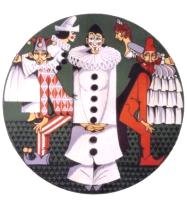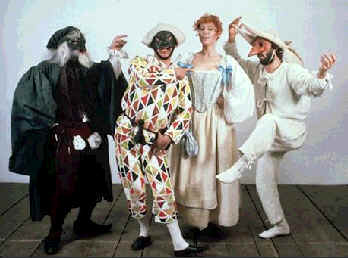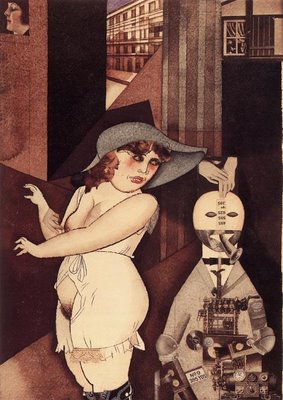


I share this with you as information about the roots of my interest in comedy in general and clowning specificly.
Alan
This article was originally published in A Short History of the Drama. Martha Fletcher Bellinger. New York: Henry Holt and Company, 1927. pp. 153-7.
THE title, Commedia dell'arte ("Comedy of Art" or "Comedy of the profession"), means unwritten or improvised drama, and implies rather to the manner of performance than to the subject matter of the play. This peculiar species had a long life in Italy, probably of about four hundred years (from the fourteenth to the eighteenth century); but it flourished especially in the sixteenth and seventeenth centuries. Of course in actual practice the play was not, in any sense, the result of the moment's inspiration. The subject was chosen, the characters conceived and named, their relations to one another determined, and the situations clearly outlined, all beforehand. The material was divided into acts and scenes, with a prologue. The situations were made clear, together with the turn of action and the outcome of each scene. When this general outline (called also scenario or canvas) was satisfactorily filled out there was left an opportunity for actors to heighten, vary, and embellish their parts as their genius might suggest. The necessity for smoothness, constant surprise, clearness, and wit called forth histrionic abilities which had been unknown to the medieval stage. "The actors had to find the proper words to make the tears flow or the laughter ring; they had to catch the sallies of their fellow-actors on the wing, and return them with prompt repartee. The dialogue must go like a merry game of ball or spirited sword-play, with ease and without a pause." [1] Such parts required actors able to make a serious study of their parts; actors who took pride in their achievements, and were willing to accept the discipline which all professional art demands. These comedians changed forever the standards of acting. The best of them stamped their parts with individuality, freshness and brilliance, and gave value to pieces which, often enough, were otherwise worthless. The Commedia dell'arte introduced the professional actor into Europe.
SUBJECTS OF THE COMMEDIA DELL'ARTE
Like the court comedies of Ariosto and Machiavelli, the Commedia dell'arte was concerned mostly with disgraceful love intrigues, clever tricks to get money or outwit some simpleton. There were the same long-lost children stolen by the Turks, the same plotting maids, bragging captains, aged fathers and wily widows. Each gentleman had his parasite, each woman her confidante. There was considerable diversity of incident, such as night scenes, in which the hero was mistaken for the villain; cases where father and son fall in love with the same girl; and risqué situations--the representation of fire, shipwreck, and the like which served as a pretext for allowing actresses to appear naked on the stage.
COMIC RELIEF
An important part of every play, given always to the most expert and popular actors, were the humorous interruptions, called lazzi, which often had nothing to do with the play itself. It might be clever pantomimic acting, acrobatic feats, juggling, or wrestling. For example, three characters meet at a cook shop, where they hear of an accident which has befallen the wife of one of them. While they express their dismay at the affliction, they fall to eating greedily from a huge dish of macaroni; and as they eat, tears stream down their faces. Or again, a servant, disgusted at an order his master has given him, delays carrying it out until he has turned a complete somersault. One famous actor could execute this trick having a full glass of wine in his hand, without spilling a drop. Another was able, in his eighty-third year, to box the ear of a fellow servant with his foot. Elaborate imitations of women taking off their stays, false hair, and crinolines were always acceptable, together with many pantomimic diversions of a less innocent character. These are examples of the lazzi of the Commedia dell'arte.
THE MASKS
In the course of the development of the Commedia dell'arte, there grew up certain traditions which held fast for many years. The rascally servant, the old man, the lady's maid, and the like--stock characters which appeared in every play--always wore a conventional dress, with masks. In general these masks may be classed under four or five groups: Pantalone and the Doctor, both old men; the Captain, a young man of adventure; the valet or jester, usually called Zanni; the hunchback Punchinello; and another old man, somewhat different from the first two.
Pantalone was usually a shop-keeper from Vienna, somewhat stupid, fond of food and of pretty women, talkative, gullible, full of temper, the butt of all the jokes--some of them very indecent--yet forgiving in the end. His business was to get deceived by his young wife, or his son, or his servant. The second old man, the Doctor, filled the part of a lawyer, an astrologer, or perhaps a philosopher from Bologna. Sometimes he represented an absent-minded pedant, quoting latin at inappropriate times, and enormously conceited. The bragging Captain, a boasting, swashbuckling officer, often Spanish, dressed-to-kill in cape, feathered hat, high boots, with sword in belt, was always a prime favorite. He told extraordinary tales about how he beat a whole army of Turks and carried off the beard of the Sultain, but when there was a hint of real danger he was the first to run away. He made love to the none-too-innocent servant maid, and got trashed by her Harlequin lover. This character, of course, is none other than the Miles Gloriosus of Plautus, called in Italy Il Capitano Spavento della Valle Inferno, or simply Spavento. In time he gained a choice variety of bombastic names in different countries: Capitano Metamoros, Capitaine Fracasse, Captain Horribilicribilifax, Ralph Roister Doister, and Bobadil.
Zanni, the scoundrelly valet or jester, resembled the Greek slave of the Middle and New Comedy. Most plays contained several valets: one each for the Doctor, Pantalone, and the primo amoroso. All were variations of the type of which Pierrot and Harlequin are the most celebrated. They were generally indolent and knavish, sometimes cunning and cruel; always stupid in their own way, first deceiving others and then being duped themselves. Alll made love to the servants, and often imitated the love scenes of their masters in ridiculous parody. Punchinello was a hunchback with a long crimson nose, dressed in a dark cloak and wearing a three-cornered cap. He too was a great rascal, but dry and less talkative than Pantalone.
All these characters had costumes, stock gestures and stage business which could be reckoned upon to create a laugh and put the audience in tune for the knavery that was to follow. In course of time there crystallized about each mask an entire code or repertory of phrases, exclamations, curses, exits, epigrammatic sayings and soliloquies appropriate to the rôle, which could be memorized and made to fill in the blank when the actor's wit could find nothing better. The primo amoroso, the female lover, and the maid servant were not masked, though they were thoroughly conventionalized. The male lover was a perfumed scapegrace; while the girl, rarely will individualized, stood simply as the helpless or ignorant foil for the intrigue. The hero became known as Flavio, Leandro or Valerio; the woman as Isabella, Lucinda, Leonora or Ardelia; while the maid servant was generally Columbine. The importance of these typical stage characters, which enjoyed at least four centuries of popularity on the European boards, lies in the influence which they exerted upon the superior dramatists of a later time. Already one can catch a breath of the Shakespearean comedies in the names of the heroes; and one can see that Molière, both as actor and author, learned much from this branch of Italian art. Its influence passed through Holberg into Denmark, where it became a powerful factor in shaping the romantic drama of a later age.




































